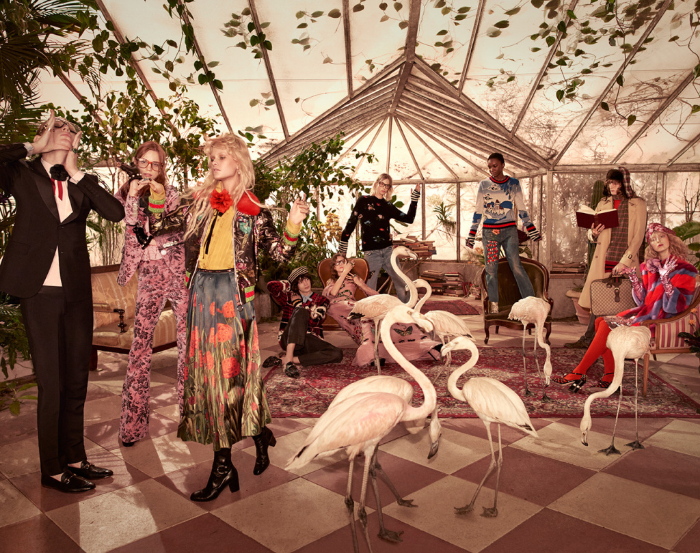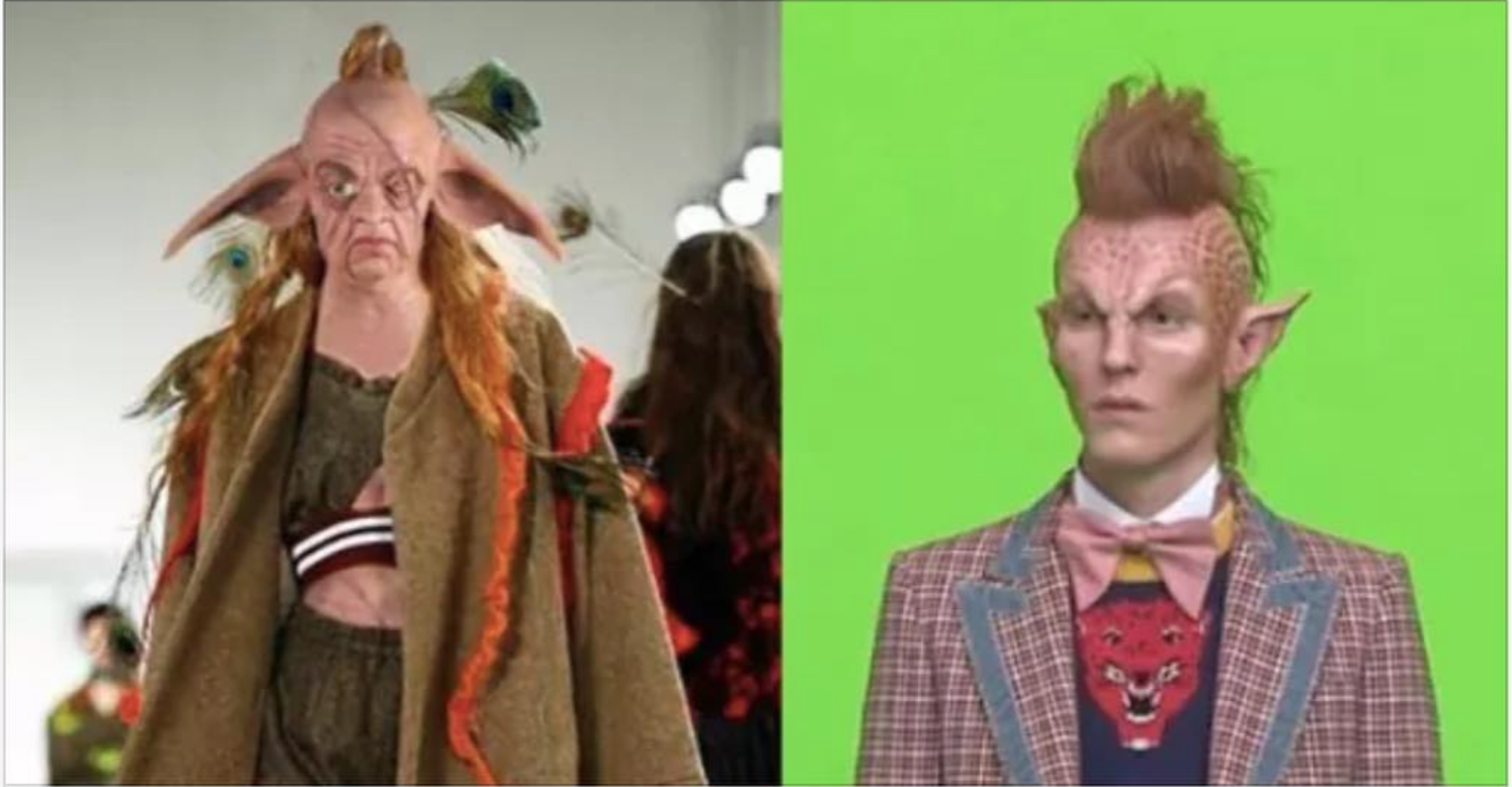
image: Gucci
Since taking the helm of Gucci in early 2015, creative director Alessandro Michele has faced quite a lot of flak for allegedly copying others’ designs. In April, Michele told BoF that the consistent copying claims are unmerited and “make [him] feel really sad.” Yet, the complaints of him taking too much “inspiration” from others do not appear to be stopping anytime soon. In fact, it seems that they are only gaining steam.
Michele spoke out about the claims of copying after he drew criticism from Central Saint Martins student Pierre-Louis Auvray, who took issue with Gucci’s use of aliens in one of its recent video campaigns. Auvray’s Instagram is rife with photos of runway looks, including those from recent Balenciaga, Louis Vuitton, Calvin Klein, Gosha Rubchinskiy, and Fenty shows, in which he doctors the model’s head into that of an alien.
One Claim of Copying After Another
Auvraytook to his Instagram account to call out Gucci, accusing the brand of “blatantly ripping-off” his work, writing: “I am just a student working hard on building my own stuff and the last thing we need as young creatives is to be ripped off.”
As noted by Vogue, an account run by students of Central Saint Martins also uploaded an image of Auvray’s work and a still from the Gucci short, writing: “Look at both accounts and write below what you make of this. Wherever your influences come from, it is vital to credit. Young emerging designers and artists only have their ideas to trade.”

A photo from Auvray’s Instagram (left) & Gucci (right)
Michele refuted the allegations, explaining that he was unaware of Auvray’s work prior to being called out for copying it. “It’s about my memories, so movies from the Seventies, including Star Trek: Lost in Space, that I saw many times. It’s more about space, we have the robots, the aliens… I tried to work with artistic director Chris Simmonds and the guys and photographer Glen Luchford on strong characters,” he said, adding that the initial idea came to him months before the video was released.
“I’m so sad, because I think it’s not a good idea for a teacher at a school like this to push a young guy to destroy, in a way, his creativity,” Michele continued, referring to the social media fury surrounding Auvray’s copying allegations. “Creativity is not about the fame. I mean, it could be possible that you are thinking something that is in the mind of someone else. The idea that I’m 45 doesn’t mean that I have no creativity. I’m like a student, it’s the same, it’s not a war!”
That was not the first – or the most recent – time that Gucci has been called out for allegedly copying. The house’s 2018 Cruise caused quite a stir due to a garment that bore a striking resemblance to one that Harlem-based designer and fashion visionary Dapper Dan showed in the 1980’s.
Even more recently, the brand is coming under fire for allegedly copying graphic designers hailing from from New Zealand and Australia.

Smythe’s design (left) & Gucci’s version (right)
New Zealand-born artist Stuart Smythe, who spoke out on Wednesday, claims that Gucci copied a twisted snake logo he designed in 2014 for his brand, CLVL Apparel Co. The allegedly infringing Gucci version was shown as part of the brand’s 2018 Cruise collection. Smythe told TFL of the alleged copying, “It’s a very obvious use of the snake and lockup from my design – Alessandro Michele even wore the shirt on the runway.”
Also speaking out this time around: Illustrator Milan Chagoury, who alleges that Gucci has co-opted a logo he designed for the White Tiger Tattoo Co. tattoo parlor in 2014 in Australia. Chagoury claims that Michele has improperly used his design on a tote bag.
Even Before That
The latest claims follow even earlier call-outs, of course, which have consistently plagued Michele from season to season. For instance, on the heels of its Spring/Summer 2016 collection, Bijules, a New York-based fine jewelry brand, and Jules Kim, the brand’s designer, kicked up a fuss, alleging that the Florence-based brand copied their nail rings. Kim told the publication that she planned to file a copyright infringement lawsuit to prevent the famed Italian design house from selling the rings, but one was never filed (likely because she lacked legal grounds).
Thereafter, artist Sonique Saturday took to her Instagram to wage war against the Italian design house for allegedly “stealing” her idea for the “REAL GUCCI” bag that went down its Fall/Winter 2016 runway, a collaboration with artist GucciGhost. No legal action was taken in that arguably meritless case, either.
Does it Matter?
These instances all taken together certainly raise the question of whether Michele is little more than a glorified copycat (OR conversely, whether these indie designers are using Michele and the visibility of the Gucci platform to achieve their own fives minutes of fame). But even more importantly, does any of this chatter matter? As to the latter question, consumers certainly do not seem to care – at least not according to the numbers.
As Bloomberg reported early this year, Gucci’s revenue advanced 21 percent in the fourth quarter, almost twice as fast as analysts expected. Full-year sales at the business, the largest under Kering’s ownership umbrella, exceeded 4 billion euros ($4.3 billion) for the first time as Michele reignited interest in the label.
Even more recently, in April, Kering announced that Gucci posted its strongest revenue increase in 20 years, with organic sales in the first quarter vaulting up 48.3 percent to 1.35 billion euros, or $1.44 billion.
And still yet, as we posited in connection with the Dapper Dan copying claims, do consumers really care about novelty enough to change their buying behavior in accordance with these passing instances of alleged copying? The preceding numbers reveal this answer to be a hard, NO!, they do not. This, of course, suggests that these social media/fashion media call-outs are little more than fleeting moments of media attention. Much like the cycle of fashion – which has been sped up to the point that everything in its wake is inherently meaningless and valueless – the fashion media is starved and pressed for content.
So, it should come as little surprise that while such copying call-outs are undoubtedly more visible and well-documented than ever before (thanks to social media), they have not proven to have a significant impact on a brand’s image or bottom line – at least not when it comes to Gucci … or Vetements or Off-White or Jeremy Scott or [insert another brand name here that has a penchant for copying].
With this in mind, it seems that a lack of novelty is a-ok in fashion (after all, when was the last time you read a Vogue Runway review that shaved off points for someone taking a bit too much inspiration from another’s existing designs? Hint: Maybe never). No, it is only on social media – and in the truly ephemeral expanse of fashion news – where these allegedly less-than-creative directors stand to run into problems … for a moment or two before consumers rush to buy that cute floral Gucci iPhone case.
* This article was initially published in June 22, 2017.










